Level 1 Driving Skills
How to adjust your mirrors
And what you should see in your mirrors and when you should check blind spots
Online Driving Course
Driving Skills for Beginners online course covering all of the routines that you will need to learn during your first driving lessons. Here we look at how to correctly set your mirrors to help you to stay safe on the road.

Use of mirrors
Is one of the main things that the driving examiner will be looking for on your driving test.
And there is good reason for this
Setting your mirrors correctly is a vital part of safe driving. Adjusting your car’s mirrors correctly reduces blind spots, improves awareness, and helps you make safer decisions on the road. Whether you’re a learner or a seasoned driver, this step-by-step guide will help you set up your mirrors effectively.
-
Adjust your seat
-
Adjust your centre mirror
-
Adjust drivers door mirror
-
Adjust passenger door mirror
Step 1: Adjust Your Seat First
Before touching the mirrors, make sure your driving seat is in the correct position:
- Sit comfortably with your back against the seat and in your normal driving position.
- Your hands should reach the steering wheel easily, with a slight bend at the elbows.
- Your feet should fully operate the pedals without stretching.
- Adjust the seat height to get a clear view over the dashboard and steering wheel.
If you do this after adjusting your mirrors then you will need to repeat the process , as your view will change when you adjust your seat and driving position.
Step 2: Adjust the centre Rear-View Mirror
The interior rear-view mirror provides a direct view of the road behind you.
- Sit in your normal driving position.
- Adjust the mirror so that you can see as much of the rear window as possible without needing to move your head.
- The rear window should be centered and fully visible.
- Avoid tilting the mirror upward, downward, or side-to-side unnecessarily.
This mirror is essential for monitoring traffic behind you and during maneuvers like reversing or lane changes.
This mirror also gives a true to life aspect of distance, as it is flat glass, unlike the door mirrors which have a convex glass for a wider view.
Step 3: Adjust the Driver’s Side Mirror
This mirror helps monitor the lane next to you and reduce blind spots on your side.
- Adjust the mirror so that you can see the side of your car on the inside edge of the mirror.
- The rest of the mirror should show the lane next to you and a portion of the road.
This method maximizes your side visibility without making the side of your car the central focus.
Step 4: Adjust the Passenger’s Side Mirror
This mirror helps you see vehicles in the adjacent lane and anything approaching from that side.
- Adjust the passenger-side mirror until you can just see the edge of your car in the mirror.
- Like the driver’s mirror, most of the view should show the lane or pavement beside your car.
This adjustment reduces the blind spot on your far side and assists during overtaking, merging or passing cyclists.
Step 5: Perform a Final Check
Once all mirrors are adjusted:
- Sit back in your normal position and confirm that you have a clear, continuous view around your car.
- There should be minimal overlap between the mirrors, which helps eliminate blind spots.
- Ensure mirrors are clean and free from obstructions like air fresheners or decorations.

0 Comments